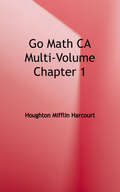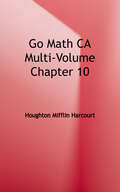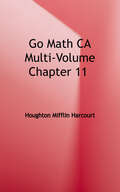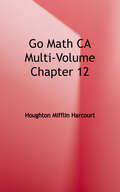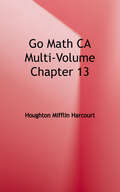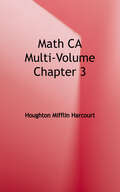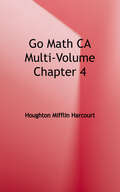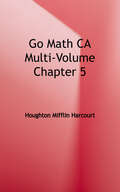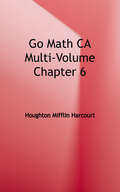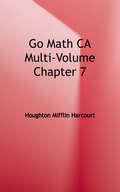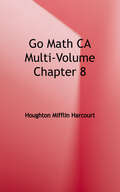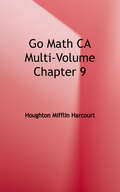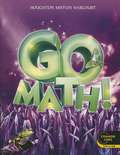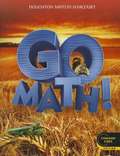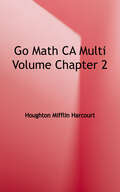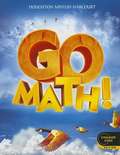- Table View
- List View
Go Math CA Multi-Volume Chapter 1
by Houghton Mifflin HarcourtCalifornia Go Math! Chapter 1 Place Value, Addition, and Subtraction to One Million In this chapter, you will explore and discover answers to the following Essential Questions: - How can you use place value to compare, add, subtract, and estimate with whole numbers? - How do you compare and order whole numbers? - What are some strategies you can use to round whole numbers? - How is adding 5- and 6-digit numbers similar to adding 3-digit numbers?
Go Math CA Multi-Volume Chapter 10
by Houghton Mifflin HarcourtCalifornia Go Math! Chapter 10 Two-Dimensional Figures In this chapter, you will explore and discover answers to the following Essential Questions: - How can you draw and identify lines and angles, and how can you classify shapes? - What are the building blocks of geometry? - How can you classify triangles and quadrilaterals? - How do you recognize symmetry in a polygon?
Go Math CA Multi-Volume Chapter 11
by Houghton Mifflin HarcourtCalifornia Go Math! Chapter 11 Angles In this chapter, you will explore and discover answers to the following Essential Questions: - How can you measure angles and solve problems involving angle measures? - How can you use fractions and degrees to understand angle measures? - How can you use a protractor to measure and classify angles? - How can equations help you find the measurement of an angle?
Go Math CA Multi-Volume Chapter 12
by Houghton Mifflin HarcourtCalifornia Go Math! Chapter 12 Relative Sizes of Measurement Units In this chapter, you will explore and discover answers to the following Essential Questions: - How can you use relative sizes of measurements to solve problems and to generate measurement tables that show a relationship? - How can you compare metric units of length, mass, or liquid volume? - How can you compare customary units of length, weight, or liquid volume?
Go Math CA Multi-Volume Chapter 13
by Houghton Mifflin HarcourtCalifornia Go Math! Chapter 13 Algebra: Perimeter and Area In this chapter, you will explore and discover answers to the following Essential Questions: - How can you use formulas for perimeter and area to solve problems? - How are area and perimeter different? - What are some methods you can use to find area and perimeter of a figure? - How could two different rectangles have the same perimeter or the same area?
Go Math CA Multi-Volume Chapter 3
by Houghton Mifflin HarcourtCalifornia Go Math! Chapter 3 Multiply by 2-Digit Numbers In this chapter, you will explore and discover answers to the following Essential Questions: - What strategies can you use to multiply 2-digit numbers? - How can you use place value to multiply 2-digit numbers? - How can you choose the best method to multiply 2-digit numbers?
Go Math CA Multi-Volume Chapter 4
by Houghton Mifflin HarcourtCalifornia Go Math! Chapter 4 Divide by 1-Digit Numbers In this chapter, you will explore and discover answers to the following Essential Questions: - How can you divide by 1-digit numbers? - How can you use remainders in division problems? - How can you estimate quotients? - How can you model division with a 1-digit divisor?
Go Math CA Multi-Volume Chapter 5
by Houghton Mifflin HarcourtCalifornia Go Math! Chapter 5 Factors, Multiples and Patterns In this chapter, you will explore and discover answers to the following Essential Questions: - How can you find factors and multiples, and how can you generate and describe number patterns? - How can you use models or lists to find factors? - How can you create a number pattern?
Go Math CA Multi-Volume Chapter 6
by Houghton Mifflin HarcourtCalifornia Go Math! Chapter 6 Fraction Equivalence and Comparison In this chapter, you will explore and discover answers to the following Essential Questions: - What strategies can you use to compare fractions and write equivalent fractions? - What models can help you compare and order fractions? - How can you find equivalent fractions? - How can you solve problems that involve fractions?
Go Math CA Multi-Volume Chapter 7
by Houghton Mifflin HarcourtCalifornia Go Math! Chapter 7 Add and Subtract Fractions In this chapter, you will explore and discover answers to the following Essential Questions: - How do you add or subtract fractions that have the same denominator? - Why do you add or subtract the numerators and not the denominators? - Why do you rename mixed numbers when adding or subtracting fractions? - How do you know that your sum or difference is reasonable?
Go Math CA Multi-Volume Chapter 8
by Houghton Mifflin HarcourtCalifornia Go Math! Chapter 8 Multiply Fractions by Whole Numbers In this chapter, you will explore and discover answers to the following Essential Questions: - How do you multiply fractions by whole numbers? - How can you write a product of a whole number and a fraction as a product of a whole number and a unit fraction?
Go Math CA Multi-Volume Chapter 9
by Houghton Mifflin HarcourtCalifornia Go Math! Chapter 9 Relate Fractions and Decimals In this chapter, you will explore and discover answers to the following Essential Questions: - How can you record decimal notation for fractions and compare decimal fractions? - Why can you record tenths and hundredths as decimals and fractions? - What are some different models you can use to find equivalent fractions? - How can you compare decimal fractions?
Go Math ¡Vivan las matemáticas! Escuela intermedia, Grado 7
by Timothy D. Kanold Edward B. Burger Juli K. DixonNIMAC-sourced textbook
Go Math ¡Vivan las matemáticas! escuela intermedia, Grado 6
by Timothy D. Kanold Edward B. Burger Juli K. DixonNIMAC-sourced textbook
Go Math! CA Multi Volume Chapter 2
by Houghton Mifflin HarcourtCalifornia Go Math! Chapter 2 Multiply by 1-Digit Numbers In this chapter, you will explore and discover answers to the following Essential Questions: - What strategies can you use to multiply by 1-digit numbers? - How can you use models to multiply a multi-digit number by a l-digit number? - How can you use estimation to check your answer? - How does the partial products strategy use place value?
Go Math! Florida [Grade 1]
by Matt Larson Thomasenia Lott Adams Juli K. DixonNIMAC-sourced textbook
Go Math! Florida [Grade 2]
by Matt Larson Thomasenia Lott Adams Juli K. DixonNIMAC-sourced textbook
Go Math! Grade 1: Practice Workbook Grade 1 (Houghton Mifflin Harcourt Go Math! Ser.)
by Houghton Mifflin HarcourtNIMAC-sourced textbook
Go Math! Grade 2, Standards Practice Book for Home or School
by Houghton Mifflin HarcourtNIMAC-sourced textbook
Go Math! Grade 3, Assessment Guide
by Houghton Mifflin Harcourt Publishing Company StaffNIMAC-sourced textbook
